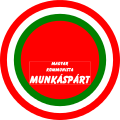Hungarian Workers' Party
show This article may be expanded with text translated from the corresponding article in Hungarian. (February 2014) Click [show] for important translation instructions. |
Hungarian Workers' Party Magyar Munkáspárt | |
|---|---|
 | |
| Leader | Gyula Thürmer |
| Founded | 17 December 1989 |
| Split from | Hungarian Socialist Workers' Party |
| Headquarters | 1046 Budapest, Munkácsy Mihály u. 51/a |
| Newspaper | A Szabadság |
| Youth wing | Baloldali Front |
| Ideology |
|
| Political position | Far-left[4] |
| European affiliation | INITIATIVE |
| International affiliation | IMCWP ICS (defunct) |
| Colours | Red |
| Slogan | Workers of the world, unite! |
| National Assembly | 0 / 199
|
| European Parliament | 0 / 21
|
| County Assemblies | 0 / 381
|
| Party flag | |
 | |
| Website | |
| www | |
| Part of a series on |
| Communist parties |
|---|
|
The Hungarian Workers' Party (Hungarian: Magyar Munkáspárt) is a communist party in Hungary led by Gyula Thürmer. Established after the fall of the communist Hungarian People's Republic, the party has yet to win a seat in the Hungarian parliament. Until May 2009 it was a member of the Party of the European Left.
History[]
The party was established as the Hungarian Socialist Workers' Party on 17 December 1989 as a successor party of the Hungarian Socialist Workers' Party (MSZMP) by a small group of old MSZMP members who opposed its transformation into the Hungarian Socialist Party (MSZP). Among them was Károly Grósz, the last general secretary of the old MSZMP, who became the new party's acting chairman
In the 1990 elections it received around 3% of the national vote, the largest share for a party that failed to win a seat.[5][6]
In 1993 the party adopted the name Workers' Party, and in the same year a group of hard-liners broke away to form another Hungarian Socialist Workers' Party. In the 1994 elections, the party won a similar share of the vote, again emerging as the largest party without a seat. Despite increasing its vote share to around 4% in the 1998 elections, the party again remained seatless. In the 2002 elections, the party's vote share fell to around 2%, and for the first time since 1990, not the largest party without parliamentary representation.[5][6]
On 12 November 2005 it became the Hungarian Communist Workers' Party when a split led to the formation of the Workers' Party of Hungary 2006 led by János Fratanolo. In the 2006 elections the party received less than 0.5% of the national vote, whilst in the 2010 elections, its vote share fell to just 0.1%. On 11 May 2013 the party was renamed again, this time becoming the Hungarian Workers' Party due to a law passed the previous year banning the public use of names associated with "authoritarian regimes of the 20th century."[7] In the 2014 parliamentary election, the party received 0.56% of the votes, again the largest party without parliamentary seats.
On the question of the 2016 migrant quota referendum, the party called for a "no" vote, expressing opposition to what it perceives as "EU aggression" against Hungary.
Ideology[]
The party opposed Hungary joining NATO. In 1996 the party organised a countrywide collection of signatures for a referendum on NATO membership. This HCWP-led referendum drive failed, although another referendum on NATO membership was held in 1997, which resulted in a vote in favour. The party continues to oppose the country's participation in NATO and other military organisations. It campaigns to have all Hungarian forces returned from abroad and to reduce the military budget. The party opposed Hungary's participation in the "democratisation" program that has previously targeted the governments of Serbia and Belarus and strongly opposed NATO campaigns in Yugoslavia against Slobodan Milošević and the 2003 invasion of Iraq.
Other foreign policies are in favour of
- a peaceful and just settlement of the Middle East crisis, in favour of the "progressive" Arab countries.
- a foreign policy based upon "good relations" with all parts of the world.
Election results[]
National Assembly[]
| Election | Votes | Seats | Rank | Government | Prime Minister candidate | |||
|---|---|---|---|---|---|---|---|---|
| # | % | ±pp | # | +/− | ||||
| 1990 | – | 0 / 386
|
±0 | 9th | extra-parliamentary | Gyula Thürmer | ||
| 1994 | 0 / 386
|
7th | extra-parliamentary | Gyula Thürmer | ||||
| 1998 | 0 / 386
|
6th | extra-parliamentary | Gyula Thürmer | ||||
| 2002 | 0 / 386
|
5th | extra-parliamentary | Gyula Thürmer | ||||
| 2006 | 0 / 386
|
8th | extra-parliamentary | Gyula Thürmer | ||||
| 2010 | 0 / 386
|
7th | extra-parliamentary | Gyula Thürmer | ||||
| 2014 | 0 / 199
|
5th | extra-parliamentary | Gyula Thürmer | ||||
| 2018 | 0 / 199
|
10th | extra-parliamentary | Gyula Thürmer | ||||
European Parliament[]
| Election year | # of overall votes | % of overall vote | # of overall seats won | +/- | Notes |
|---|---|---|---|---|---|
| 2004 | 56,221 | 1.83% (6th) | 0 / 24
|
||
| 2009 | 27,829 | 0.96% (7th) | 0 / 22
|
||
| 2019 | 14,452 | 0.42% (9th) | 0 / 21
|
Gallery[]

Logo from 1989 to 1993

Logo from 1993 to 2005

Logo from 2005 to 2013
Notes[]
- ^ Nordsieck, Wolfram. "Hungary". Parties and Elections in Europe. Archived from the original on 5 April 2004. Retrieved 20 April 2019.
- ^ "Thürmer Gyula: Nemzeti vagy vörös? Nemzeti és vörös! Balszemmel" (in Hungarian). 15 February 2019.
- ^ (in Hungarian) https://munkaspart.hu/mi-ti-2/5754-a-lego-a-liberalis-politikaval-tomi-a-gyermekeink-fejet. Retrieved 8 June 2020. Missing or empty
|title=(help) - ^ Jeffries, Ian (2002), Eastern Europe at the Turn of the Twenty-First Century: A guide to the economies in transition, Routledge, p. 212
- ^ Jump up to: a b Nohlen & Stöver (2010), p. 924.
- ^ Jump up to: a b Nohlen & Stöver (2010), p. 932.
- ^ "Hungarian CWP, New name of the Hungarian CWP". Solidnet. 14 May 2013. Archived from the original on 2 October 2016. Retrieved September 18, 2018.
References[]
- Nohlen, D.; Stöver, P. (2010). Elections in Europe: A data handbook. Baden-Baden: Nomos. ISBN 978-3-8329-5609-7.
External links[]
- Party website (in Hungarian)
- A szabadság Weekly newspaper of the party
- Baloldali Front Party's youth organization
- Hungarian Workers' Party Facebook
- Hungarian Workers' Party Twitter
- 1989 establishments in Hungary
- Communist parties in Hungary
- Eurosceptic parties in Hungary
- Party of the European Left former member parties
- Political parties established in 1989
- Opposition to NATO
- Marxist parties


